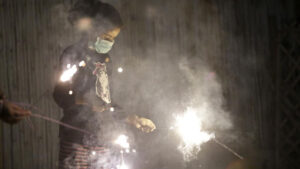Physical Address
23,24,25 & 26, 2nd Floor, Software Technology Park India, Opp: Garware Stadium,MIDC, Chikalthana, Aurangabad, Maharashtra – 431001 India
Physical Address
23,24,25 & 26, 2nd Floor, Software Technology Park India, Opp: Garware Stadium,MIDC, Chikalthana, Aurangabad, Maharashtra – 431001 India

CLAIM
Green Firecrackers are safe and eco-friendly. They are not harmful to humans or to the environment.
FACT
Greenwashing. If compared to conventional firecrackers, ‘green firecrackers’ lead to a reduction in air and noise pollution only to a certain extent and are still harmful to humans and to the environment.
WHAT THEY SAY
Green Crackers were developed to check the increasing pollution levels in various parts of the country due to the burning of traditional crackers. They are eco-friendly and do not emit particulates and toxicities that can be harmful to the environment as well as to human beings.
WHAT WE FOUND
Of late, ‘Green Firecracker’ has become the buzzword during Diwali in India, especially in North Indian cities like Delhi where air pollution reaches alarming levels during this time of the year. Air pollution caused by stubble burning combined with the toxic particulates emitted by bursting firecrackers makes matters worse for a region already reedling under severe pollution caused by automobiles and industries. Add to that unfavorable meteorological conditions preventing pollutants from dispersing and diluting.
The concept of green firecrackers was introduced with the claim that they will help in checking rising pollution levels and that they are a safer and greener alternative to conventional firecrackers. Green crackers were formulated to minimize noise and air pollution by reducing PM10 and PM2.5 by 30–35% and sulphur and nitrogen oxides by 35–40% with a sound level of less than 120 dB. They were promoted as an ‘eco-friendly way of celebrating Diwali’. But, are green firecrackers indeed safe and eco-friendly? Or is this a form of ‘greenwashing’ in the Indian cracker industry?
(Are you wondering what ‘Greenwashing’ actually is? Do you want to know about Greenwashing in detail? Here is an explainer by CFC India.)
Reduces pollution only to a certain extent
As per CSIR-NEERI, which developed formulations for ‘green’ crackers, they reduce particulate matter (PM 2.5) emissions by 30% compared to conventional ones. According to experts, this approach of defining a product as ‘green’ in terms of a PM 2.5 level reduction fails to consider the multifaceted effects of these emissions. Further, a reduction in pollution by 30-35% cannot be regarded as a criterion to declare a product ‘green’ or ‘eco-friendly’.
Experts have clarified that like the conventional ones, green crackers too essentially contain various chemical toxic compounds, though in lesser quantities. The Hindu quoted Pratima Singh, a research scientist who leads the Air Pollution domain at CSTEP, as saying that green crackers don’t solve any purpose because they too emit fine particle matter in the air.
“They are not a dependable and safer replacement to regular firecrackers, but they are only a low-emission and less harmful alternative. Green crackers alternative, yet harmful chemicals like potassium nitrate and aluminium instead of magnesium and barium, and carbon instead of arsenic and other harmful pollutants,” The Hindu report further quoted Mr. Madhusudhan Anand, CTO and co-founder, Ambee, as saying.
Might be more dangerous than conventional ones
It has come to light that so-called ‘green firecrackers’ might actually be more harmful than conventional ones. According to a study by Delhi Technological University (DTU), green crackers produce a very high concentration of ultra-fine particles (EFP) that are far more dangerous than PM2.5 and PM10. The study carried out during Diwali 2019 found that the emission of fine particles with a much smaller diameter was much higher from green crackers than from conventional crackers.
The research conducted by Shailendra Kumar Yadav, Rajeev Kumar Mishra from DTU and Bhola Ram Gurjar from IIT-Roorkee was published in the scientific journal Elsevier. Ultra-fine particles are more dangerous as they are deposited in the lungs as they have the ability to penetrate tissues or directly get absorbed into the bloodstream.
No significant reduction in sound pollution
As per the Noise Pollution (Regulation and Control) Rules, 2000, the safe noise limit in residential areas at night is 45 dB. Regular crackers emit about 160 dB of sound, whereas green crackers have a sound level of 110-125 dB. These levels are far more than double the permissible noise limit and actually are not significant in terms of reducing sound pollution. According to the Centers for Disease Control and Prevention (CDC), prolonged exposure to noise above 70 dB can impact hearing and loud noise above 120 dB can cause immediate damage to the ears.
Fakes
The sale of conventional crackers by portraying them as ‘green crackers’ is another problem. There is a lack of awareness and authentic practice of manufacturing green crackers in many parts of the country. A Mumbai-based non-governmental organization (NGO) Awaaz Foundation had written to the National Environmental Engineering Research Institute (NEERI), bringing their attention towards the sale of spurious firecrackers being sold under the guise of ‘green crackers’. A Hindustan Times reality check recently found that conventional crackers are being sold in the name of green crackers in Lucknow.
Under the above circumstances, we conclude that projecting so-called ‘green firecrackers’ as ‘green’ and ‘eco-friendly’ disregards the fact that they are equally harmful to human beings and to the environment even if less than the conventional ones by some percentages. Thus this points to ‘greenwashing’.
(with inputs from Aayushi Sharma)
Comments are closed.
[…] English […]
[…] Also, read this in English […]